WORLD OF MICROBES Notes 9th Science Lesson 19 Notes in English
WORLD OF MICROBES Notes 9th Science Lesson 19 Notes in English
Introduction
- Microbiology (greek words: mikros -small, bios- life bearing, logy- study), is a branch of biology that deals with living organisms of microscopic size, which include bacteria, fungi, algae, protozoa and viruses.
- Microbes are found in habitats like terrestrial, aquatic, atmospheric or in living hosts.
- Some of them survive in extreme environments like hot springs, ice sheets, water bodies with high salt content and low oxygen, and in arid places with limited water availability.
- Some of the microorganisms are beneficial to us and they are used in the preparation of curd, bread, cheese, alcohol, vaccines and vitamins, while some others are harmful causing diseases to plants and animals including human being.
- This lesson will explore the beneficial and harmful effects of microbes in relation to welfare of human kind.
Microbes and their Types
- Microorganisms differ from each other in size, morphology, habitat, metabolism and several other features.
- Microbes may be unicellular (Bacteria), multicellular (Fungi), acellular (not composed of cells-Virus).
- Types of microbes include bacteria, viruses, fungi, microscopic algae and protists.
Bacteria
- Bacteria are microscopic, single celled prokaryotic organisms without nucleus and other cell organelles.
- Although majority of bacterial species exist as single celled forms, some appear to be filaments of loosely joined cells.
- The size varies from less than 1 to 10 µm in length and 0.2 to 1 µm micrometer in width. Bacteria may be motile or non-motile.
- Special structures called flagella are found on the cell surfaces for motility

a. Shapes of bacteria
- Based on the shapes, bacteria are grouped as:
- Spherical shaped bacteria called as cocci (or coccus for a single cell).
- Rod shaped bacteria called as bacilli (or bacillus for a single cell).
- Spiral shaped bacteria called as spirilla (or spirillum for single cell).
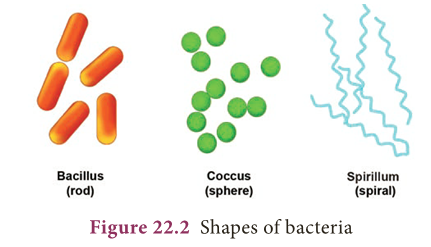
b. Structure of a bacterial cell
- Bacterial cell has cell membrane, covered by strong rigid cell wall.
- In some bacteria, outside the cell wall there is an additional slimy protective layer called capsule made up of polysaccharides.
- The plasma membrane encloses the cytoplasm, incipient nucleus (nucleoid), ribosomes and DNA which serve as genetic material.
- Ribosomes are the site of protein synthesis.
- They lack membrane bound organelles. In addition to this, a small extra chromosomal circular DNA called plasmid is found in the cytoplasm.
Viruses
- The term ‘virus’ in Latin means ‘venom’ or ‘poisonous fluid’.
- Viruses are non-cellular, self- replicating parasites.
- They are made up of a protein that covers a central nucleic acid molecule, either RNA or DNA.
- The amount of protein varies from 60% to 95% and the rest is nucleic acid. Nucleic acid is either DNA (T4 bacteriophage) or RNA (Tobacco mosaic virus, TMV).
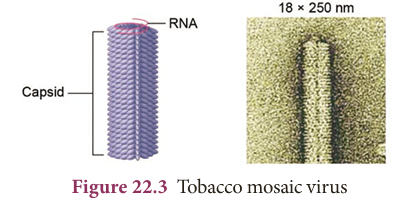
- A simple virus particle is often called a virion.
- They grow and multiply only in living cells. They are the smallest among the infective agents varying over a wide range from 18-400 nm (nanometre).
- They can live in plants, animals, human being and even bacteria. They can be easily transmitted from one host to another.
a. Characters of Viruses
- Viruses exhibit both living and non-living characters.
Living characters of viruses
- They have the nucleic acid (DNA or RNA) i.e., the genetic material that can replicate.
- They can multiply in the living cells of the host.
- They can attack specific hosts.
Non-living characters of viruses
- Viruses remain as inert material outside their hosts.
- They are devoid of cell membrane and cell wall. Viruses are devoid of cellular organelles like ribosomes, mitochondria, etc.
- They can be crystallised.
b. Types of Viruses
- Viruses are categorised as given below:
- Plant virus: Virus that infect plants. e.g. Tobacco mosaic virus, Cauliflower mosaic virus, Potato virus.
- Animal virus: Virus that infect animals. e.g. Adenovirus, Retrovirus(HIV), Influenza virus, Polio virus.
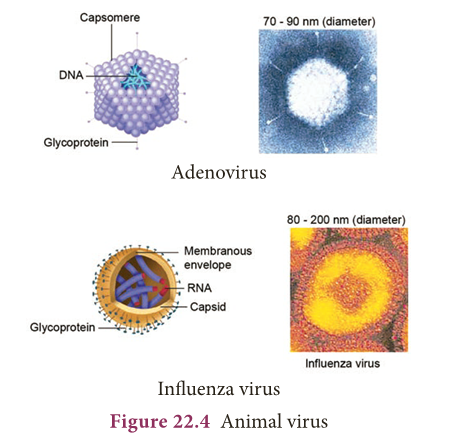
- Bacteriophages: Virus that infect bacterial cells. e.g.T4 bacteriophage.
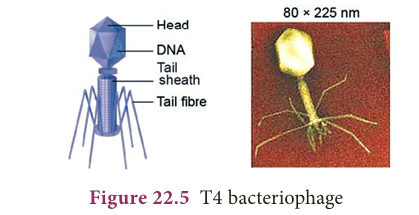
Fungi
- They lack chlorophyll, hence depend on living or dead host for their nutritional needs.
- Fungi living on living hosts are called parasites, and those living on dead organic matter are called saprophytes.
- The body of the fungus is called thallus.
- Single celled yeast ranges from 1 to 5 µm in width.
- They are spherical in shape.
- Flagella are absent and hence they are non-motile.
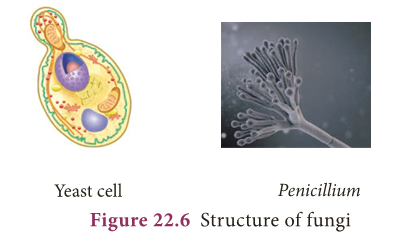
- In the case of multicellular forms, thallus is called mycelium.
- Mycelium is a complex of several thin filaments called hyphae (singular: Hypha).
- Each hypha is 5 to 10 µm wide. They are tube like structures filled with protoplasm and cellular organelles.
- Cell wall is made up of cellulose or chitin.
- Cytoplasm contains small vacuoles filled with cell sap, nucleus, mitochondria, golgi body, ribosomes, and endoplasmic reticulum.
- Food material is stored in the form of glycogen or oil globules.
- They reproduce vegetatively (binary fission, budding and fragmentation), asexually (spore formation-conidia) and sexually (male and female gametangium are called antheridium and oogonium).
Prions
- The term ‘prion’ was coined by Stanley B. Prusiner in 1982.
- Prions are viral particles which contain only proteins. They do not contain nucleic acid.
- They are infectious and smaller than viruses.
- Prions are found in neurons and are rod shaped.
- Prions induce changes in normal proteins.
- This results in the degeneration of nervous tissue.
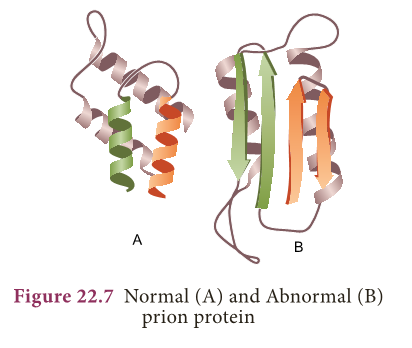
Applications of Microbes
- Microorganisms contribute to human welfare in many ways.
- In this section we will study about the diversified usefulness of microbes.
Microbes in Agriculture
- Microbes play an important role in agriculture as biocontrol agents and biofertilizers.
- Microbes play a vital role in the cycling of elements like carbon, nitrogen, oxygen, sulphur and phosphorus.
- These are called biological scavangers.
- Microbes as biofertilizers: Microorganisms which enrich the soil with nutrients are called as biofertilizers.
- Bacteria, cyanobacteria and fungi are the main sources of biofertilizers.
- Nitrogen is one of the main source of plant nutrients.
- Atmospheric nitrogen has to be converted to available form of nitrogen.
- This is done by microbes either in free living conditions or by having symbiotic relationship with the plants. e.g. Azotobacter, Nitrosomonas Nostoc (free living), symbiotic microbes like Rhizobium, Frankia.
Activity 1
- Take the root nodules of any pulse or leguminous plant available in your locality.
- Wash it throughly with water.
- Crush the nodules on a clean glass slide.
- Add a drop of distilled water to the crushed material on the glass slide.
- Observe the preparation under compound microscope.
- Microbes as biocontrol agents: Microorganisms used for controlling harmful or pathogenic organisms and pests of plants are called as biocontrol agents (Biopesticides).
- Bacillus thuringiensis (Bt) is a species of bacteria that produces a protein called as ‘cry’ protein.
- This protein is toxic to the insect larva and kills them.
- Spores of B.thuringiensis are available in sachets, which are dissolved in water and sprayed on plants infected with insect larva.
Microbes in Industries
- Microorganisms play an important role in the production of wide variety of valuable products for the welfare of human beings.
- Production of fermented beverages: Beverages like wine are produced by fermentation of grape fruits by Saccharomyces cerevisiae.
- Curing of coffee beans, tea leaves and tobacco leaves: Beans of coffee and cocoa, leaves of tea and tobacco are fermented by the bacteria Bacillus megaterium.
- This gives the special aroma.
- Production of curd: Lactobacillus sp. converts milk to curd.
- Production of organic acids, enzymes and vitamins: Oxalic acid, acetic acid and citric acid are produced by fungus Aspergillus niger.
- Enzymes like lipases, invertase, proteases, and glucose oxidase are derived from microbes.
- Yeasts are rich source of vitamin-B complex.
Microbes in Medicine
- Antibiotics: These are metabolic products of microorganisms, which in very low concentration are inhibitory or detrimental to other microbes.
- In 1929, Alexander Fleming produced the first antibiotic pencillin. In human beings antibiotics are used to control infectious diseases like cholera, diptheria, pneumonia, typhoid, etc.
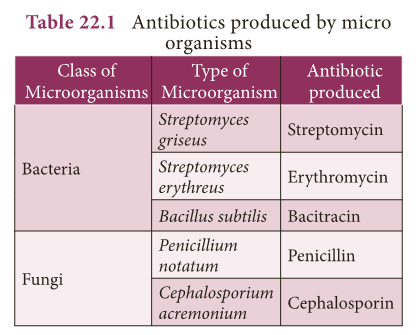
- Vaccines: These are prepared by killing or making the microbes inactive (attenuated).
- These inactive microbes are unable to cause disease, but stimulate the body to produce antibodies against the antigen in the microbes.
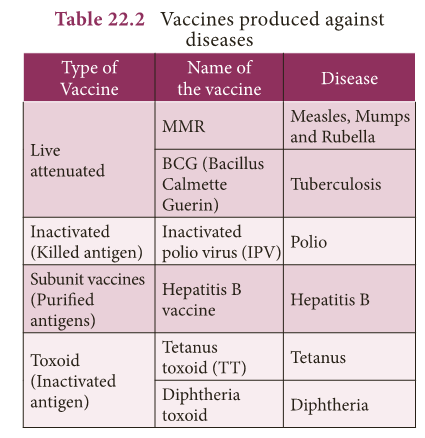
Microbes and Diseases
- Disease (dis = against; ease = comfort) can be defined as an impairment or malfunctioning of the normal state of the living organism that disturbs or modifies the performance of vital functions of the body.
- Disease can be categorized based on:
- The extent of occurrence (endemic, epidemic, pandemic or sporadic).
- Whether infectious or non-infectious.
- Types of pathogen – whether caused by bacterial, viral, fungal or protozoan infections.
- Transmitting agent – whether air borne, water borne or vector borne.
Classification of Disease based on Occurence
- Endemic: Disease which is found in a certain geographical area affecting a fewer number of people (low incidence). e.g. Occurrence of goitre in Sub-Himalayan regions.
- Epidemic: Disease which breaks out and affects large number of people in a particular geographical region and spreads at the same time. e.g. Influenza.
- Pandemic: Disease which is widely distributed on a global scale. e.g. Acquired Immuno deficiency Syndrome (AIDS).
- Sporadic: Disease which occur occasionally. e.g. Malaria and Cholera.
Manifestation of Disease
Communicability of diseases
- Infectious diseases are communicable diseases.
- They are caused by external factors like pathogenic organisms (bacteria, virus, vectors, parasites) invading the body and causing diseases. e.g. Influenza, Tuberculosis, Chickenpox, Cholera, Pneumonia, Malaria, etc
- Non-infectious diseases are non- communicable diseases.
- They are caused by internal factors like malfunctioning of organs, genetic causes, hormonal imbalance and immune system defect. e.g. Diabetes, Coronary heart diseases, Obesity, Cancer, Goitre, etc Point of entry and place of infection
- The disease causing microbes enter the body through different means.
- An infection develops when these pathogens enter the human body through contaminated air, water, food, soil, physical contact, sexual contact and through infected animals.
- They may be organ specific or tissue specific within our body where microbes reside.
Reservoir of infection
- Reservoir of infection refers to the specific environment in which the pathogens can thrive well and multiply without causing diseases. eg. Water, soil and animal population.
Incubation period
- The interval between infection and first appearance of the diseases is called incubation period.
- It may vary from few hours to several days.
Infection
- Infection is the entry, development or multiplication of an infectious agent in the human body or animals.
Harmful Effects of Microbes
- Pathogens cause disease in two ways.
- They are tissue damage and toxin secretion.
- Tissue Damage: Many pathogens destroy the tissues or organs of the body causing morphological and functional damage.
- For example, bacterium of pulmonary tuberculosis damages the cells of the lungs, and virus causing hepatitis destroys liver tissue.
- Toxin Secretion: Many pathogens secrete poisonous substances called toxins which cause tissue damage leading to diseases.
- Let us now study about the causative organism, mode of infection, occurrence, symptoms and preventive measures of a few airborne, waterborne, vectorborne and sexually transmitted diseases.
Airborne Diseases
- Human beings inhale atmospheric air.
- Due to continuous inhalation of contaminated air the chances for airborne microorganisms to find a host and cause infection are higher.
- Most of the respiratory tract infections are acquired by inhaling air containing the pathogen that are transmitted through droplets caused by cough or sneeze, dust and spores.
- Airborne diseases are caused by bacteria and viruses.
- A few air borne diseases and their modes of transmission are given in the table below.
Airbone disease caused by the virus:


Waterborne Diseases
- Microbes present in the contaminated water cause various infectious diseases.
- Some of the water borne diseases are cholera, typhoid, infectious hepatitis, poliomyelitis, diarrhoea, etc.
- The most common waterborne diseases and their causative microbial agents, symptoms of these diseases and preventive measure are given in the tables below.
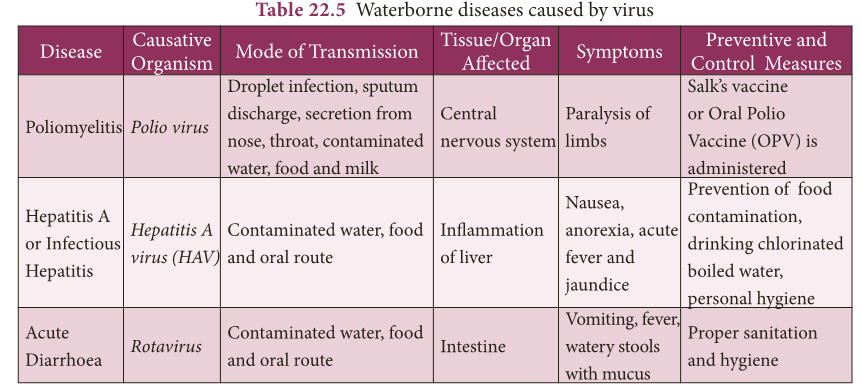
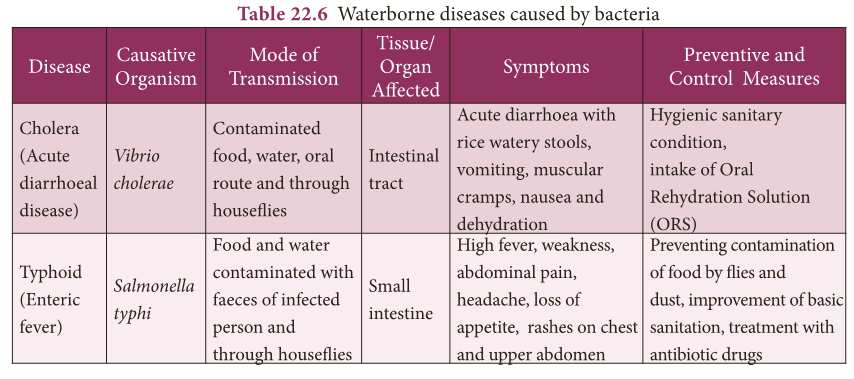
Vector Borne Diseases
- Vector is an agent that acts as an intermediate carrier of the pathogen.
- Many insects and animals act as vectors.
- Diseases transmitted by vectors are called vector borne diseases.
- These vectors can transfer infecting agents from an infected person to another healthy person.
- Some of the insect vector borne diseases are Malaria, Filaria, Chikungunya, Dengue, and the diseases which are transmitted through animals are Bird flu and Swine flu.
Malaria
- Malaria continues to be one of the major health problems of developing countries. Malaria is caused by protozoan parasite Plasmodium.
- Four species of Plasmodium namely, P.vivax, P.malariae, P.falciparum and P.ovale cause malaria.
- Malaria caused by Plasmodium falciparum is malignant and fatal.
- Approximately 300 million people around the world get infected with Malaria every year.
- It spreads through the bite of an insect vector, the female Anopheles mosquito which feeds on human blood and usually lasts less than 10 days.
- A person affected by malaria will show symptoms of headache, nausea, muscular pain, chillness and shivering, followed by rapid rise in temperature.
- Fever subsides with profuse sweating.
- Use of Quinine drugs kills the stages of malaria parasite.
Chikungunya
- Chikungunya is caused by virus.
- It is transmitted in humans by the bite of infected Aedes aegypti mosquito during the day time.
- It causes severe and persistent joint pain, body rashes, headache and fever.
- Joint pains can last for a very long time. Incubation period of the virus is usually 2-12 days.
- Chillness, high fever, vomiting, nausea, headache, persistent joint pain and difficulty in walking are the common symptoms associated with this disease.
- The joints get inflamed and the person finds it difficult to walk.
- Paracetamol is given to relieve pain and reduce fever.
Dengue
- Dengue is known as break bone fever.
- The name break bone fever was given due to the cause of intense joint and muscle pain.
- Dengue fever is caused by virus. It is transmitted by Aedes aegypti mosquito.
- Incubation period of the virus is usually 5-6 days.
- Onset of high fever, severe headache, muscle and joint pain, rashes, haemorrhage, fall in blood platelet count are the symptoms associated with this disease.
- Vomiting and abdominal pain, difficulty in breathing, minute spots on the skin signifying bleeding within the skin are also associated with dengue fever.
- Paracetamol is given to reduce fever and body ache.
- Complete rest and increased intake of fluid is essential.
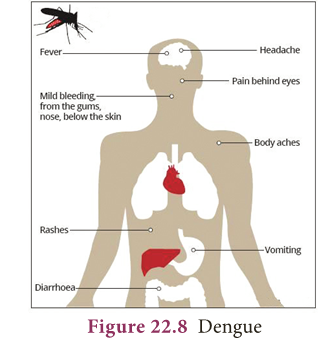
Filaria
- Filariasis is a major health problem in India.
- This disease is caused by nematode worm Wuchereria bancrofti.
- The adult worms are usually found in the lymphatic system of man. It is transmitted by the bite of infected Culex mosquito.
- Incubation period of filarial worm is 8-16 months and the symptoms include acute infection, fever and inflammation in lymph glands.
- In chronic infection the main feature is elephantiasis which affects the legs, scrotum and the arms.
Mosquitoes – Prevention and Control
- Prevention of mosquito bites by using mosquito nets, mosquito screens, mosquito repellents and ointments.
- Elimination of breeding places by providing adequate sanitation, underground waste water disposable system and drainage of stagnant water.
- Collection of water in any uncovered container such as water tank, pots, flower pots, discarded tyres should be avoided.
- Control of mosquito larvae by spraying oil on stagnated water bodies.
- Adult mosquitoes can be killed by spraying insecticides.
- Application of citronella oil or eucalyptus oil on the exposed skin.
Diseases Transmitted by Animals
Swine Flu
- Swine Flu first originated from pigs. It is caused by virus that affects pigs and has started infecting humans.
- The virus spreads through air. It affects the respiratory system.
- Influeuza virus H1N1 has been identified as the cause of this disease.
- It is transmitted from person to person by inhalation or ingestion of droplets containing virus from people sneezing or coughing.
- Fever, cough, nasal secretion, fatigue, headache, sore throat, rashes in the body, body ache or pain, chills, nausea, vomiting and diarrhoea, and shortness of breath are the symptoms associated with the disease.
Prevention and Control
- Administration of nasal spray vaccine.
- Avoiding close contact with a person suffering from flu.
- Intake of water and fruit juices will help prevent dehydration.
- Plenty of rest will help the body to fight infection.
- Always wash hands and practice good hygiene.
Avian Influenza
- Avian influenza is a contagious bird disease caused by viruses.
- Birds that can carry and spread avian influenza virus include poultry (chickens, turkeys or ducks), wild birds and pet birds.
- It is caused by Influenza Virus H5N1.
- The incubation period of the virus is 2-7 days. People who have close contact with infected birds or surfaces that have been contaminated by the bird’s secretion from mouth, eyes, mucus, nasal secretion or droppings (bird faeces) transmit this disease. Fever, cough, sore throat, running nose, muscle and body aches, fatigue, headache, redness of eyes (conjunctivitis) and difficulty in breathing are the symptoms of this disease.
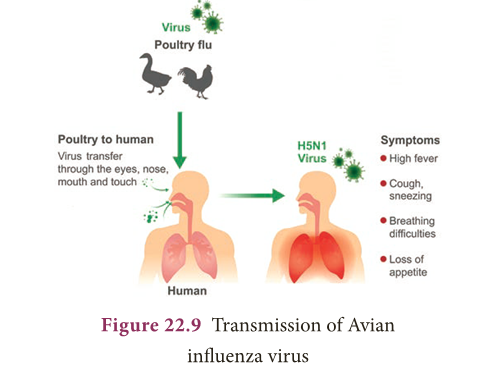
Prevention and Control
- Avoiding open air markets where infected birds are sold.
- Avoiding contact with infected birds or consumption of infected poultry.
- Proper cleaning and cooking of poultry.
Sexually Transmitted Diseases
- Some pathogens are transmitted by sexual contact from one partner to another and not by casual physical contact.
- A few sexually transmitted diseases are AIDS, Gonorrhea, Genital warts, Genital herpes and Syphilis.
AIDS
- Acquired Immunodeficiency Syndrome (AIDS) is caused by retrovirus (RNA virus) known as Human Immunodeficiency Virus (HIV).
- The virus attacks the white blood cells or lymphocytes and weakens the body’s immunity or self defence mechanism.
- It is transmitted through sexual contact (from infected person to a healthy person), blood contact (transfusion of unscreened blood), by surgical equipments (infected needles and syringes), maternal – foetal transmission (from infected mother to the foetus).
- Weight loss, prolonged fever, sweating at night, chronic diarrhoea are some of the important symptoms.
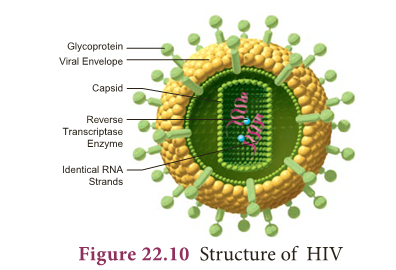
Prevention and Control
- Disposable syringes and needles should be used.
- Protected and safe sexual contact.
- Screening of blood before blood transfusion.
- Avoid sharing shaving blades/razors.
- People should be educated about AIDS transmission.
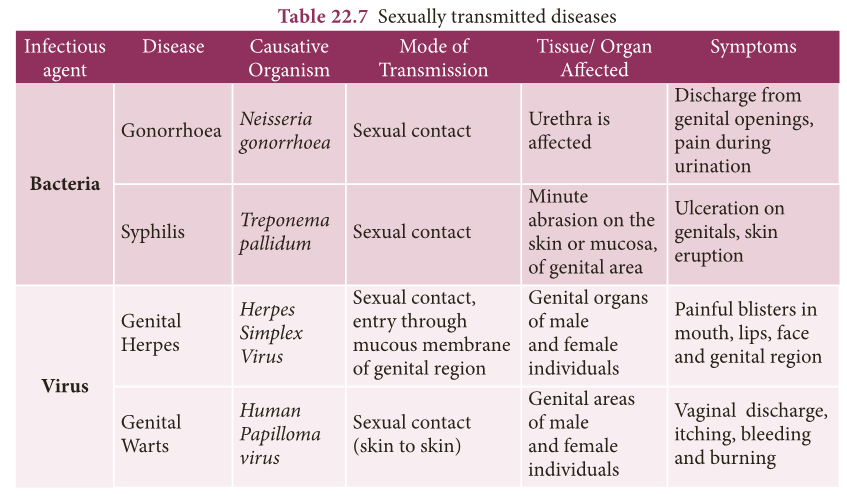
Hepatitis -B or Serum Hepatitis
- It occurs due to infection of hepatitis-B virus (HBV).
- The virus damages the liver cells causing acute inflammation and cirrhosis of liver.
- It is transferred from infected mother to their babies or by sexual contact.
- It is also transmitted by contact with infected person’s secretions such as saliva, sweat, tears, breast milk and blood.
- Symptoms observed are fever, loss of appetite, nausea vomiting, yellowness of eyes and skin, light coloured stools, itching of skin, headache and joint pain.
Prevention and Control
- Screening of blood donors before blood donation can prevent the transmission.
- Injection of drugs to be prevented.
- Having safe and protected sex.
- Sharing of razors should be avoided.
- The hepatitis B vaccine offers excellent protection against HBV.
- The vaccine is safe and highly effective.
- Some of the other sexually transmitted diseases caused by bacteria and virus are discussed in Table 22.7.
Immunization
- Immunization is a process of developing resistance to infections by administration of antigens or antibodies.
- Inoculation of vaccines into the body to prevent diseases is called as vaccination.
- One effective way of controlling the spread of infection is to strengthen the host defenses.
- This is accomplished by immunization, which is one of the cost effective weapon of modern medicine.
- When a large proportion of a community is immunized against a disease, the rest of the people in the community are benefited because the disease does not spread.
Vaccines and its Types
- Vaccines are preparation of living or killed microorganisms or their products used for prevention or treatment of diseases.
- Vaccines are of two types:
- Live vaccines and Killed vaccines Live Vaccines: They are prepared from living organisms.
- The pathogen is weakened and administered. e.g. BCG vaccine, oral polio vaccine.
- Killed Vaccines: Micro organisms (bacteria or virus) killed by heat or chemicals are called killed or inactivated vaccines.
- They require a primary dose followed by a subsequent booster dose. e.g. Typhoid vaccine, cholera vaccine, pertussis vaccine.
Immunization Schedule
- The World Health Organization in the year 1970 has given a schedule of immunization for children.
- This schedule is carried out in almost all countries.
- Table 22.8 gives the schedule of vaccination procedures followed in India.
- BCG (Bacillus Calmette Guerin): This was prepared by two French workers Calmette and Guerin (1908-1921).
- The bacilli are weakened and used for immunization against tuberculosis.
- DPT (Triple Vaccine): It is a combined vaccine for protection against Dipetheria, Pertussis (whooping cough) and Tetanus.
- MMR: Mumps, Measles, Rubella vaccine gives protection against viral infections.
- DT: It is a dual antigen or combined antigen. It gives protection from Diphtheria and Tetanus.
- TT (Tetanus Toxoid): Toxin of Tetanus bacteria.
- TAB: Combined vaccine for typhoid, paratyphi A and paratyphi B.
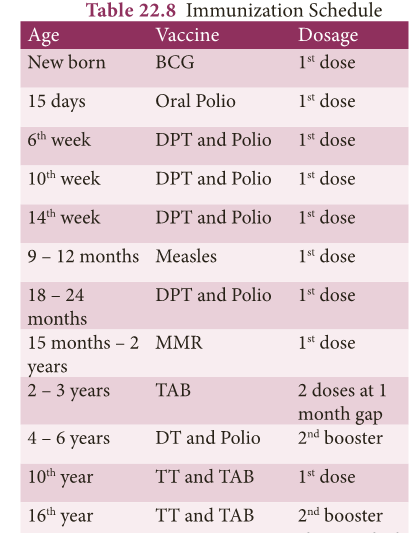
Activity 3
- Recently in 2018, Nipah virus was in the headlines of the daily newspaper. Collect the following information.
- What is Nipah virus?
- How it gets transmitted?
- Mention the preventive measures taken by the Government to check the disease.
MORE TO KNOW:
Antonie Van Leeuwenhoek
- Antonie Van Leeuwenhoek, the first microbiologist designed his own microscope.
- In 1674, he took plaque from his own teeth and observed it under the microscope.
- He was astonished to see many tiny organisms moving around, which was otherwise invisible to naked eyes.
Viroids
- The protein free pathogenic RNA of virus is Viroids.
- They are found in plant cells and cause disease in plants.
FACTS:
- World Health Day – 7th April
- World Malaria Day – 25th April
- World AIDS Day – 1st December
- World Anti -Tuberculosis Day – 24th March
Robert Koch
- Robert Koch (Father of Bacteriology) is the first German physician to study how pathogens cause diseases.
- In 1876, he showed that the disease called anthrax of sheep was due to Bacillus anthracis which exist in pastures in the form of protective spores.
Sir Ronald Ross
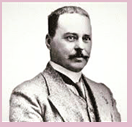
- Sir Ronald Ross, an Indian born British doctor, is famous for his work concerning malaria.
- He worked in the Indian Medical Service for 25 years.
- He identified the developing stages of malarial parasite in the gastrointestinal tract of mosquito and proved that malaria was transmitted by mosquito.
- In 1902, he received the Nobel Prize for Physiology or Medicine for his work on the transmission of malaria.
Nilavembu Kudineer
- An extraction of tender leaves of papaya and herbal drink Nilavembu Kudineer is given to dengue patients.
- It is known to increase the blood platelet count. (Source: AYUSH)
Swine flu
- Swine flu first surfaced in April 2009 and affected millions of people.
- Then in June 2009 it was declared a pandemic by the World Health Organization (WHO).
- In 2015, India reportedly had over 31,000 people infected and 1,900 resulting deaths.
(H5N1)
- The avian influenza virus A (H5N1) emerged in 1996.
- It was first identified in Southern China and Hong Kong.
- H5N1 was first discovered in humans in 1997 by World Health Organisation.
- First outbreak was in December 2003.
HIV
- HIV was first recognised in Hatai (USA) in 1981.
- In India the first confirmed evidence of AIDS infection was reported in April 1986 from Tamil Nadu.
- The AIDS vaccine RV 144 trial was conducted in Thailand in 2003 and reports were presented in 2011.
Vaccination
- The process of vaccination was introduced by Edward Jenner.
- According to the World Health Organisation (WHO), Jennerian vaccination has eliminated small pox totally from the human population.
Know your Scientist
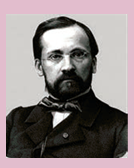
- Louis Pasteur is an 18th century French chemist and microbiologist. He coined the term vaccine.
- Pasteur developed vaccine against chicken pox, cholera, anthrax, etc.
EXTRA POINTS:
- Antibiotics: Substances that kill or prevent the growth of microorganisms.
- Biofertilizer: Microorganisms which enrich the soil with nutrients.
- Biopesticides: Agents which control insect pests in natural way without causing harm to the environment.
- Flagella: Lash-like appendage protruding from the cell body of bacterial cell.
- Immunisation: Process by which the body produces antibodies against the specific vaccine when administered.
- Pathogen: A biological agent that causes disease to its host. e.g. bacteria,virus etc.
- Prions: Viral particles which contain only protein. They do not contain nucleic acid.
- Vaccines: Preparation of antigenic proteins of pathogens (weakened or killed) which on inoculation into a healthy person provides temporary / permanent immunity against a particular disease.